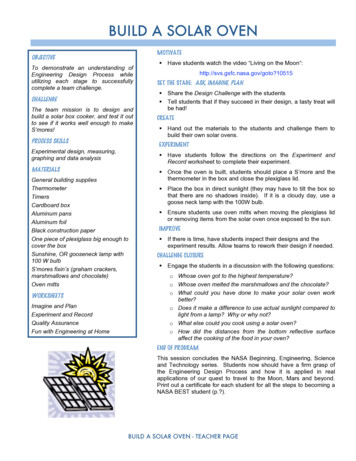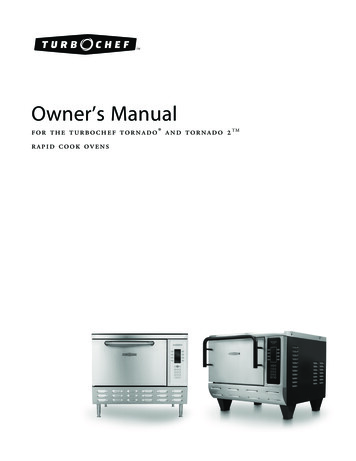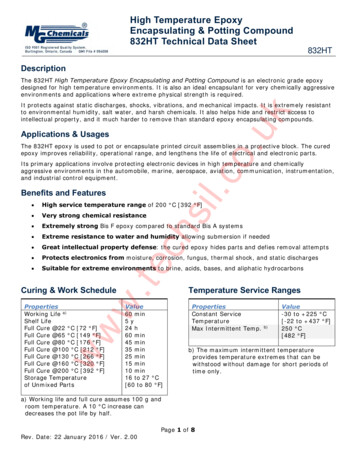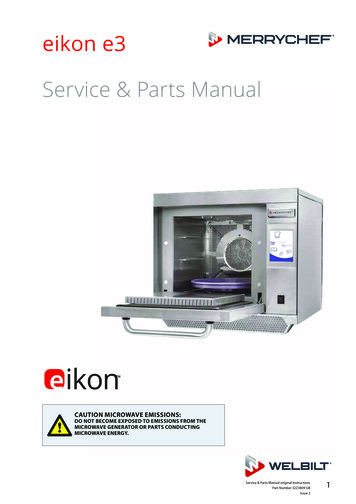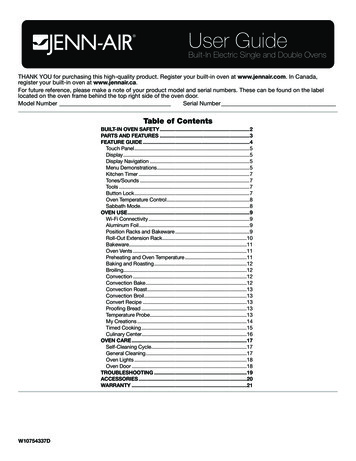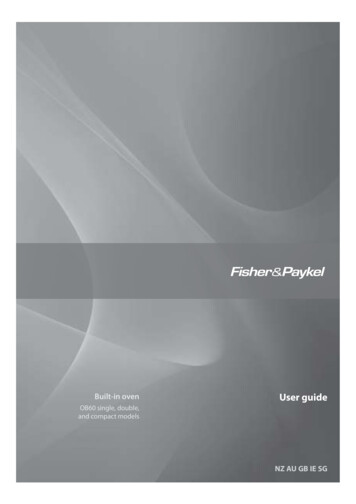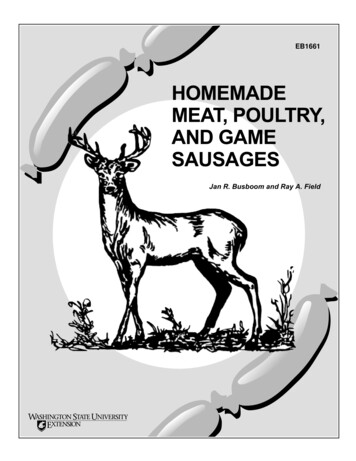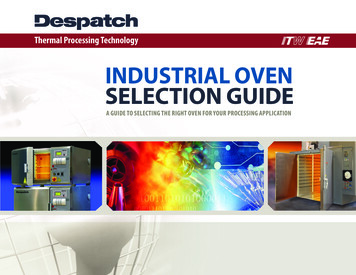
Transcription
Thermal Processing TechnologyINDUSTRIAL OVENSELECTION GUIDEA GUIDE TO SELECTING THE RIGHT OVEN FOR YOUR PROCESSING APPLICATION
1. DEFINE YOUR APPLICATIONCOMMON APPLICATIONSThe first and most important step in finding the right piece ofequipment is to determine what function your equipment needs to serve.The scope of thermal applications is endless and can range from commonto complex.Annealing – heating and slow cooling in orderto toughen and reduce brittleness.You should also consider the environment that the oven needs to operatein. If you are using the oven in a clean room you will need a clean processoven. If you are using the oven in a laboratory for testing, you will mostlikely be looking for a small oven with the ability to document test results.Drying - removal of moisture (waterthat is not chemically bound)Curing – controlled heating of asubstance to promote or control a chemicalreaction.Baking - Heating to a low temperaturein order to remove entrained gases.Sterilization - eliminates or kills all forms of lifepresent on a productDepyrogenation – the use of dry heat at hightemperatures to destroy pyrogensBurn-In Testing - process of stressing components to test for failureHeat Treating – changing metalproperties such as hardness, strength, flexibilityand stress resistance.Aging – rapid weathering of metal to achieve astable surface condition
2. DETERMINE WHETHER A BATCH ORCONTINUOUS MODEL OVEN WILL WORKBEST FOR YOUR PROCESSBatch OvensFor applications where the load size or production volumes varysubstantially, batch processing is a good approach. Batch ovens arealso ideal for situations that require a high degree of flexibility interms of process variables such as temperature or dwell (soak) time.Continuous OvensWhere a large quantity of similar product pieces are processed,continuous operation may be the optimal approach. Continuousovens help ensure consistent thermal processing times for eachpart in high-volume applications, such as manufacturing electroniccomponents or automotive parts. Continuous ovens may also allowseveral discrete processes to be combined, reducing material handling and increasing throughput.
3. CHOOSE THE BEST CHAMBER SIZETO SUIT YOUR PROCESSING NEEDSOVEN SIZE CATEGORIESLab or Benchtop OvensChamber size depends on the size of the product or parts, the number ofproducts in each batch, and the number of batches required per day to meetproduction requirements. If the interior space is too small, insufficient spacebetween parts results in poor performance. If it is too large, space, time andenergy are wasted.Because of their small, convenient size, theseovens are used for laboratory test and development applications, as well as production applications that require small batch loads. These ovensrange in chamber size from 1 cubic foot to 27cubic feet (28 to 764 liters).When using forced recirculating airflow, parts benefit from spacing, but theoven can be loaded more densely vertically because airflow is distributedalong the entire side wall. Parts should be kept 2-3 inches (5.1 - 7.6cm) fromthe oven walls.Cabinet OvensThis size is referred to as a reach-in oven becausethey are ergonomically designed for easy loading and unloading. Cabinet ovens are floormounted, very efficient in terms of footprint andtypically range in size from 4 to 35 cubic feet.Walk-In and Truck-In OvensLarge batch ovens can accommodate a widevariety of specific product/process needs. Theyare suitable for loading by fork truck or manually. Typically truck-in ovens ranges from 52 to210 cubic feet, and walk-in ovens start at 360cubic feet and larger.
4. CONSIDER YOURTEMPERATURE REQUIREMENTSWhen considering the temperature requirements for your application, firstnote the minimum and maximum operating temperatures required.Additional temperature considerations include:uuuu The required dwell time at temperature, and the overall cycle time.T he type and amount of product load. The oven design will need to havesufficient heating capacity to bring the product to the desired temperaturewithin the specified time. hether the heat-up rate needs to be controlled or if the product can beWallowed to reach temperature as quickly as possible. Any specific cool-down requirements.OVEN HEATING CAPACITYDoes the oven have sufficient heatingcapacity to bring the product to thedesired temperature within thespecified cycle time?The answer to this question depends on themass and specific heat of the product. This isthe energy required just to heat the product.The heating capacity of the oven will need tobe greater, due to heat losses through the ovenwalls, through exhausted air and through heating of the oven mass itself.Can the product absorb heat at a rate sufficientto reach temperature within the specified timeframe?The product may not be able to reach the desiredtemperature in the desired time frame, eventhough the heating capacity of the oven is sufficient. The rate at which a product can absorbheat is dependent on the thermal conductivity of the material, the size and shape of theproduct, and the velocity and direction at whichthe convected air impinges the surface of theproduct.
5. KNOW HOW CRITICAL TEMPERATUREUNIFORMITY IS FOR YOUR PROCESSNINE-POINT UNIFORMITY TESTUniformity is critical to consistent heat processing results. It is typicallyexpressed as the maximum difference between the highest and lowesttemperatures in a chamber at a specified setting. For example, 2C at200 C, as tested in a 9 Point Uniformity Survey.FACTORS THAT INFLUENCE TEMPERATURE UNIFORMITY INCLUDE:u Cold air stratification (cold air entering chamber)u Accuracy and response speed of controlleru Heat loss through oven walls or door/door sealu Placement of workloadu Ability to direct the air through the chamberu Volume and weight of products being processedBefore implementing a critical thermal processing step you need to confirm that the ovenyou are using is delivering the temperatureuniformity required for your process.A nine point uniformity test that measurestemperature in every corner as well as thecenter of the oven will ensure that the temperature throughout the oven remains relativelyconstant.
6. CHOOSE THE BEST AIRFLOW FORYOUR PRODUCT LOADIn most cases a forced convection oven with recirculating airflow will providethe best distribution of heat and significantly speeds the time-to-temperatureand heat transfer to parts. Temperature uniformity and performance depends ona fan design that directs air to all areas of the c hamber.Your product and how it is loaded will determine what type of airflow will provide uniform distribution of heat to all parts of the load. For instance, if yourproduct is to be loaded on a solid tray, horizontal airflow is the best option.Consider how parts can be spaced with each type of airflow to ensure optimalairflow through or around all parts of the load.HorizontalVertical (up or down)Uniflow is a combination of vertical up and horizontalairflow typically used in walk-in and truck-loading ovens.Ideal for large products with an uneven shape.Uniflow
7. DESIGN AND CONSTRUCTIONCONSIDERATIONSMaximum temperature of the oven and size of the workchamber will affect the construction methods used. Standard ovenconstruction includes a mild steel exterior finished in a scratch resistant paint, sufficient insulation to minimize heat loss, easily readablecontrols, and a door system with sufficient thermal expansion andstructural integrity to avoid warping.Several process-specific factors need to be taken into account inregard to oven construction. You will need a stainless steel interiorwhenever high degrees of cleanliness, cleanability and resistance tocorrosion are required. Surface temperature specifications may require special construction techniques and load support design willdepend on the type and weight of the load.A wide variety of floor types are available. You’ll need to considerwhat’s best for your application. Options include a metal panel floorfor surface mounting, recessed into the existing factory floor, orsurface mounted with insulating cement. Truck loaded ovens use aninsulated floor with recessed channel tracks or rails to guide the truckinto position.OVEN QUALITYProper Oven Construction:u Improves temperature uniformityand performanceu Reduces heat loss and energyexpensesu Simplifies cleaning and serviceOven Interior Considerations:u Stainless steel provides corrosion resistanceand cleans easily.u Aluminized and mild steel are less expensive,but offer less protection against corrosion,rust and contamination.u Shelves should feature a sturdy, non-tipdesign, and allow for proper airflow and easyproduct loading/unloading.Look for Applicable Standardsu U.L. & C-UL listed oven, U.L. & C-UL listedcontrol panel (available as an option) and CEconformance arelistings that are a sign of quality.
8. DEFINE ANY SPECIALPROCESSING NEEDSYour application may require a clean process oven to prevent particulate contamination of sensitive products. The oven will need specialconstruction and components, such as a HEPA filter or other special airfiltration system, stainless steel for cleaning and continuous back welding to prevent migration of particles into the oven.Inert atmosphere ovens provide nitrogen or argon gas, whichsome processes require to prevent product oxidation at elevatedtemperatures.The National Fire Protection Association (NFPA) requires speciallydesigned “Class A” ovens for direct, gas-fired equipment, or forprocessing products involving flammable solvents, volatiles orcombustible materials.SPECIALTY OVEN FEATURES Clean Process OvenuHEPA filter or other specialair filtration systemsu Rounded corners for cleaningu Continuous back weldingClass A Ovenu Forced exhaust, to keep flammable vaporconcentrations well below the LowerFlammable Limit (LFL)u A purge timer that operates in conjunctionwith forced exhaust to purge volatiles beforeheaters are energized.u An airflow switch, required to prove exhaustairflow.u Explosion relief panel, designed to relieve andvent pressure through an explosion relief areaor plug.Inert Atmosphere Ovenu Inert gas is injected into the chamber, pressur-izing the oven and replacing the oxygen.u The chamber features high integrity welds andspecial motor sealsu Cooling systems such as water coils or air-to-air heat exchanger.
9. DEFINE WHAT CONTROLLERCAPABILITIES ARE NEEDEDSPECIALTY OVEN FEATURESDESPATCH PROTOCOL 3Controllers play a key role in overall oven performance. Despatch usesmicroprocessor-based, digital proportioning controllers. Precise temperature control is achieved with a thermocouple sensor and solid stateheater controls.uuS ingle setpoint controllers are simplest to use and are appropriatewhen the process requires one setpoint temperature. rogrammable ramp/soak controllers are appropriate when multiplePsetpoint temperatures are required, or when the rate of heating mustbe controlled.The Despatch Protocol 3TM controllercan function either as a programmableramp/soak controller or as a singlesetpoint controller. A Modbus 485 serial communications port allows datacommunication between the ovencontroller and a PC. Ethernet connection is available as an option.With Protocol Manager software, theuser may interface with up to 32 ovensfrom a single PC. This powerful toolprovides data logging of critical operating information, recipe managementand remote monitoring capability.
10. SELECT A STANDARD OVEN ORCONTACT A PRODUCT SPECIALISTFOR A CUSTOM CONFIGURATIONCongratulations! You made it through the list! Now you should have apretty clear idea of what type of equipment you need for your specificprocess. In case you should need additional assistance, please take alook at the summary chart listed on the next page, or consult one ofour Product Specialists.WE’RE HERE TO HELPCustom SolutionsIf you have a unique application,Despatch engineers can addressyour custom requirements for heatup times, cool down times, temperature uniformity, instrumentation,record keeping, space requirements,and other special concerns.Product SpecialistsDespatch’s product specialists aretrained to help you quickly find theright product for your process orapplication.Call toll free in the US: 1-800-726-0550International customers: 1-952-469-5424
Process Oven ApplicationsCommon ApplicationsAir Flow TypeMaximumTemperatureInterior Oven Sizeand DirectionSpecial ConditionModelPass Through (optional)LBB Forced ConvectionBenchtop OvensTesting, Curing, Drying, Annealing2 to 27 cu.ft. (66 to 765 liters)204 C/400 FUniflowTesting, Curing, Drying, Annealing1 to 18 cu.ft. (28 to 510 liters)260 C/500 FHoriz. Recirc.Testing, Curing, Drying, Bonding1.6 to 14 cu.ft. (45 to 396 liters)350 C/662 FHoriz. Recirc.ISO Class 5 (Class 100) (Class A,Inert optional)LCC/LCD Clean ProcessCuring, Drying, Sterilizing, Aging4.2 cu. ft. (119 liters)343 C/650 FHoriz. Recirc.Class A - RFDRAD/RFD BenchtopLAC High PerformanceCabinet/Reach-In OvensCuring, Drying, Sterilizing, Aging4.2 to 35 cu.ft. (119 to 991 liters)343 C/650 F*Horiz. Recirc.Class A - RFDRAD/RFD CabinetTesting, Curing, Drying, Bonding14 cu. ft. (396 liters)350 C/662 FHoriz. Recirc.ISO Class 5 (Class 100) (Class A,Inert optional)LCC/LCD2-14Clean Process CabinetPreheating and Testing Pipes2.7 to 4 cu.ft. (76.5 to 113.3 liters)260 C/500 F*Horiz. Recirc.Top LoadingPTC Top-LoadingPolyimide Curing14 cu. ft. (396 liters)350 C/662 FHoriz. Recirc.ISO Class 5 (Class 100)PCO2-14 Polyimide CuringCabinetBurn-in, Reliability Testing18 cu. ft. (510 liters)260 C/500 FHoriz. Recirc.Sterilization, Depyrogenation30 to 180 cu.ft. (850 to 5,097 liters)285 C/545 FHoriz. Recirc.ISO Class 5 (Class 100) PassThroughSD Clean ProcessInert atmospherePBC Burn-in CabinetWalk-In OvensAging, Bonding, Curing, Drying,Finish Baking, Heat Treating, Burn-InAging, Annealing, Curing52 to 216 cu.ft. (1,490 to 6,116 liters)343 C/650 FHoriz. Recirc.Class A - TFDTAD/TFD Walk-in476 to 952 cu.ft.(13,450 to 26,960 liters)343 C/650 FUniflowClass A (optional)TAD/TFD Large Walk-InConveyor OvensPreheating, Curing, Bonding, Drying, Heat treating 1.7 to 12.5 cu. ft. ( 48 to 354 liters)260 C/500 FHoriz. Recirc.Optional Class Aor HEPA filteredPCC Series ContinuousNote: Rating of “Class A” ovens is determined by flammable/volatile loading at a given operating temperature. Flammable/volatile ratings should never be exceeded.Property damage, bodily injury or death could occur if ratings are not followed. Please consult the factory if your process involves volatiles, combustible materials or solvents.SERVICE AND TECHNICAL SUPPORTGLOBAL HEADQUARTERSWWW.DESPATCH.COMservice parts: 1-800-473-7373international service/main: 1-952-469-8230service fax: 1-952-469-8193main phone: 1-800-726-0110international/main: 1-952-469-5424sales: 1-800-726-0550international/sales: 1-952-469-82408860 207th Street WestMinneapolis, MN 55044 tch.comThermal Processing Technology 2017 ITW EAE, a division on Illinois Tool Works.All rights reserved. Despatch is a registeredtrademark in the U.S. and other countries.Industrial Oven Selection Guide 06-17
in. If you are using the oven in a clean room you will need a clean process oven. If you are using the oven in a laboratory for testing, you will most likely be looking for a small oven with the ability to document test results. Annealing - heating and slow cooling in order to toughen and reduce brittleness. Curing - controlled heating of a
